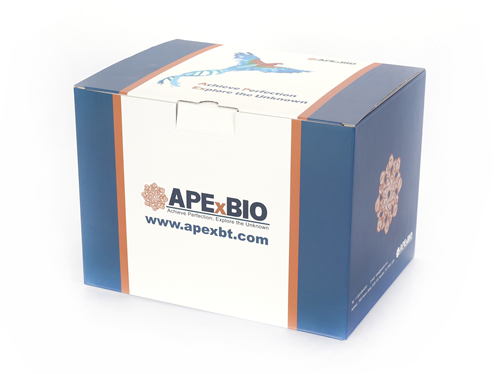PF-4708671
PF-4708671 is a cell-permeable and highly specific inhibitor of p70 ribosomal S6 kinase 1 with IC50 value of 160nM [1].
S6K1 is a regulator of various biology processes. The inhibition of S6K1 is regard as a therapeutic for the treatment of cancer and insulin resistance. PF-4708671 is the first reported inhibitor of S6K1. It inhibits the activity of S6K1 in the in vitro assay with Ki value of 20nM. For the isolated S6K1 from HEK293 cell, PF-4708671 shows inhibition with IC50 value of 160nM. The inhibition of S6K1caused by PF-4708671 is much more potent than of other related kinases such as RSK2 and MSK1. Besides that, PF-4708671 prevents S6K1 from phosphorylating its substrates including the ribosomal S6 protein, mTOR and Rictor. In addition, PF-4708671 is found to enhance the phosphorylation of S6K1 at Thr229 and Thr389, results in a subsequent increase of S6K1 activity. Whereas this increased activity is much less than that stimulated by IGF1 [1].
References:
[1] Pearce L, Alton G, Richter D, et al. Characterization of PF-4708671, a novel and highly specific inhibitor of p70 ribosomal S6 kinase (S6K1). Biochem. J, 2010, 431: 245-255.
| Physical Appearance | A solid |
| Storage | Store at -20°C |
| M.Wt | 390.41 |
| Cas No. | 1255517-76-0 |
| Formula | C19H21F3N6 |
| Solubility | ≥37.8 mg/mL in DMSO; ≥17.13 mg/mL in EtOH; insoluble in H2O |
| Chemical Name | 2-[[4-(5-ethylpyrimidin-4-yl)piperazin-1-yl]methyl]-6-(trifluoromethyl)-1H-benzimidazole |
| SDF | Download SDF |
| Canonical SMILES | CCC1=CN=CN=C1N2CCN(CC2)CC3=NC4=C(N3)C=C(C=C4)C(F)(F)F |
| Shipping Condition | Small Molecules with Blue Ice, Modified Nucleotides with Dry Ice. |
| General tips | We do not recommend long-term storage for the solution, please use it up soon. |
| Kinase experiment [1]: | |
|
Protein kinase activity assays |
For selectivity IC50 assays, purified active GST–S6K1, GST–S6K2, His–MSK1 (residues 2–802), His–RSK1 (residues 1–735) and His–RSK2 (residues 2–740) (0.5 units/ml) were assayed for 30 min at 30°C in a 50 μl assay mixture in buffer A containing either 30 μM Crosstide (GRPRTSSFAEG, for S6K1, S6K2 and MSK1) or 30 μM Long S6 (KEAKEKRQEQIAKRRRLSSLRASTSKSGGSQK, for RSK1 and RSK2), 10 mM magnesium acetate and 100 μM [γ - 32P]ATP. Reactions were terminated and the incorporation of [γ -32P]phosphate into the peptide substrate was determined by applying the reaction mixture on to P81 phosphocellulose paper and scintillation counting after washing the papers in phosphoric acid. One unit of activity was defined as that which catalysed the incorporation of 1 nmol of [32P]phosphate into the substrate. To determine the Ki for PF-4708671, full-length recombinant S6K1 was added to a final concentration of 5 nM to Omnia assay buffer containing various concentrations of compound. The reaction was run for 60 min at 30℃ in a 50 μl assay volume. The fluorescence of the peptide was monitored at an excitation wavelength of 360 nm and an emissionwavelength of 485 nm. The rate of the reaction at each compound concentration was normalized to the DMSO control rate, and this normalized rate against concentration was fitted to the Morrison tight-binding equation for a competitive inhibitor to provide the true Ki. In order to assay S6K activity in HEK-293 cell lysates, cells were lysed in Tris lysis buffer. Lysate (0.5 mg) was incubated with 5 μg of S6K antibody conjugated to Protein G–Sepharose for 1 h at 4℃ on a vibrating platform. Immunoprecipitates were washed twice with lysis buffer and twice with buffer A, and kinase activity was assayed exactly as described above using the Crosstide peptide. |
| Cell experiment : | |
|
Cell lines |
HEK-293 cells, A549, SK-MES-1 and NCI-H460 cells |
|
Preparation method |
The solubility of this compound in DMSO is >10 mM. General tips for obtaining a higher concentration: Please warm the tube at 37℃ for 10 minutes and/or shake it in the ultrasonic bath for a while. Stock solution can be stored below -20℃ for several months. |
|
Reacting condition |
0.1-10 μM for 16-72 h |
|
Applications |
PF-4708671 inhibited S6K1 activity and induced S6K1 phosphorylation in HEK-293 cells [1]. Moreover, PF-4708671 significantly inhibited cell proliferation and invasion ability in A549, SK-MES-1 and NCI-H460 cells in vitro, resulting in cell cycle arrest in G0-G1 phase [2]. |
| Animal experiment [2]: | |
|
Animal models |
Nude mouse xenograft model |
|
Dosage form |
50 mg/kg; intraperitoneal administration, daily for 1 week; |
|
Applications |
PF-4708671 inhibited tumor growth in a nude mouse xenograft model established with H460 cells in vivo. |
|
Other notes |
Please test the solubility of all compounds indoor, and the actual solubility may slightly differ with the theoretical value. This is caused by an experimental system error and it is normal. |
|
References: 1. Pearce, L. R., Alton, G. R., Richter, D. T., Kath, J. C., Lingardo, L., Chapman, J., Hwang, C. and Alessi, D. R. (2010) Characterization of PF-4708671, a novel and highly specific inhibitor of p70 ribosomal S6 kinase (S6K1). Biochem J. 431, 245-255 2. Qiu, Z. X., Sun, R. F., Mo, X. M. and Li, W. M. (2016) The p70S6K Specific Inhibitor PF-4708671 Impedes Non-Small Cell Lung Cancer Growth. PLoS One. 11, e0147185 |
|
| Description | PF-4708671 is a cell-permeable inhibitor of p70 ribosomal S6 kinase (S6K1 isoform) with Ki/IC50 values of 20 nM/160 nM,respectively. | |||||
| Targets | p70 S6K1 | |||||
| IC50 | 160 nM (Ki=20 nM) | |||||
Quality Control & MSDS
- View current batch:
Chemical structure

Related Biological Data













